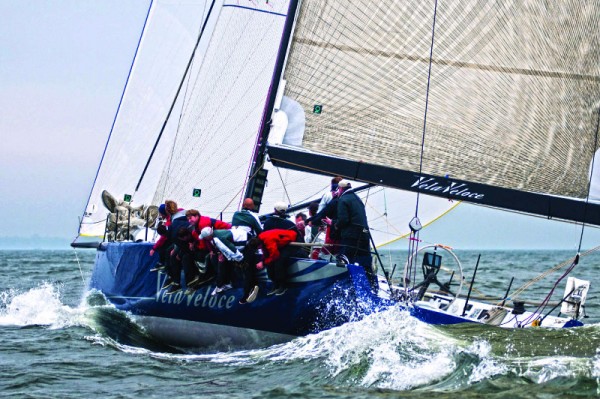I was out blasting around testing reaching spinnakers the other day on a new C&C 30, and I was reminded of how much fun sending it on a close reach really was. So much of our time racing these days is spent sailing windward-leeward courses that the fine art of sailing on a windy tight reach at the edge of control has almost become a lost art. It is a particularly useful skill in point-to-point and distance races. So how do you keep on the hairy edge while avoiding the wipeout?
Step #1: Have patience
The first mistake is to try to head up and sail toward the mark before you are ready. No matter how badly you want to get there, you have to have everyone in position, hiking like crazy with all the weight well aft before you start to head up. Weight is the key. If people are still on the bow, or trimmers are down in the boat, you are not ready to go. When the spinnaker is first hoisted, start at a comfortably low angle, get everyone set, and then work gradually up. Don’t worry about the mark.
Step #2: Easy in the puffs
It’s all in the hands of the trimmers. Every puff needs to be met with a generous ease of mainsail and spinnaker sheet (if you are jib reaching, ease the jib). As soon as you feel the heel start to increase, ease. Have a crew member on the rail calling puffs. Ease aggressively initially, and then trim in as the power of the puff is turned into speed. Sails will have to move in and out constantly. It is a sport!
A couple of notes on trim: the spinnaker luff should be tight. If using an asymmetrical, pull the tack line down tight. Fly the pole low with symmetrical sails. A tight luff will pull the shape forward and open up the back end of the sail. If you are jib reaching, you need to set up an outboard lead on the rail. Mainsail trim is largely a function of vang tension. Vang should be well eased in general and let off in the puffs or whenever there is too much heel.
Step #3: Anticipate and drive aggressively
Upwind, it is all about minimizing rudder movement and staying smooth. On a windy reach you can be aggressive. The helm is going to have plenty of load. You can fight it. The real trick is to anticipate. As the puff hits and the boat starts to heel, bear off aggressively to keep the boat flat. Once the power of the puff has been turned into speed, head back up. The faster you are going, the easier it is to sail higher angles. Sync with your trimmers, bearing off as they ease, heading up as they re-trim. Watch the leading edge of the spinnaker. Don’t get ahead of your trim. Notice I have never suggested looking at the mark. The mark is irrelevant. You will either make it or not as you average out bearing off in the puffs and then back up in the light spots. If you are not going to make it, don’t panic. There will be a perfect moment where, if you take the spinnaker down, you end up on a comfortable jib reach to the mark.
Step #4: If you wipe out
You will wipe out on occasion. If you don’t, you aren’t trying hard enough. First, trimmers should keep easing even if the sail collapses, if there is too much heel and the boat is rounding up. Let the vang go completely. As a helmsperson, if you realize you are losing it, do the opposite of what your instinct tells you to do. Stop fighting and let the boat head up and broach. The trick is to maintain enough speed and attached flow of water on the rudder that when the sails luff completely and the boat starts to flatten out, you can bear off. As the boat comes down with sails flogging, the trimmers need to be ready. As soon as the boat goes flat, trim like crazy. You will have a long way to go, since you let the sails completely out. You will end up well low, of course. That’s okay. You are starting over. It is just like you sailed when you first put the spinnaker up. Get the boat under control, and then gradually head back up.
Tactical note
The classic tactical response when faced with a reach that is a marginal spinnaker carry is to head up early in the leg so you can set the spinnaker later. This is completely wrong. In fact, the opposite approach is best. It’s okay to come around the mark and hold for a couple of minutes to check things out. But as soon as it looks like you might be able to carry it, go for it. The worst case scenario is that you will end low of the mark and have to jib reach at the end. That is still faster than jib reaching at a less than ideal angle for the whole leg. More often than not, you will make it! Find more racing tips at spinsheet.com/quantum-racers-edge.
Address questions to [email protected]. ~David Flynn





